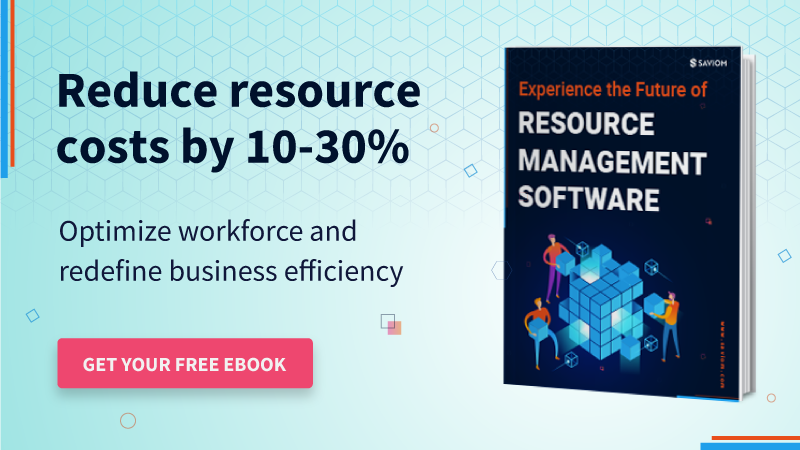In today’s business environment, resources are more than just a vital asset — they are key differentiators that define an organization’s success. As a result, workforce planning has evolved from a traditional HR function to a strategic imperative that directly impacts an organization’s competitive edge and operational efficiency.
Operational workforce planning, a subset of workforce planning, bridges the gap between an organization’s short-term goals and its talent capabilities. This process enables businesses to effectively attract, retain, and deploy skilled resources to meet immediate priorities or demands.
By streamlining resource allocation and boosting productivity, operational planning empowers organizations to respond swiftly to market demands while driving long-term success.
This blog explains the benefits of operational planning and elucidates the steps to create a robust operational plan.
Let’s begin.
What is Operational Workforce Planning?
Operational workforce planning serves as the roadmap for achieving an organization’s short-term goals and objectives, generally set for a span of the next six months to one year. The process also comprises tracking day-to-day operations, assigning people to meet immediate resource demands, and addressing ad-hoc changes to enhance operational efficiency.
HRs and mid-level managers are responsible for preparing these plans, which outline the targets to be achieved over the next year.
These operational plans can be divided into two categories:
- Single-use plans, designed for one-time business goals (e.g., launching a new product)
- Ongoing plans, which address continuous improvements or recurring issues (e.g., boosting team efficiency).
Let’s understand operational workforce planning better with the help of a real-life example of an IT industry.
An IT company has to cut down on its labor costs by 20% in the upcoming fiscal year.
So, what can operational workforce planning comprise?
It can encompass measures like:
- Going beyond matrix organizational boundaries to hire global and cost-effective resources.
- Creating the right mix of senior and junior resources to control project resource costs.
- Establishing a fine balance between permanent and contingent workforce to reduce unnecessary overhead costs.
- Implementing resourcing techniques like the out rotation-backfill strategy to combat resourcing constraints and fill critical positions without hiring critical and niche-skilled resources.
- Providing shadowing opportunities for freshers or less experienced resources whose charge-out rates are comparatively lower to reduce resourcing costs.
Now that the concept of operational workforce planning is clear, let’s understand how valuable it is for an organization.
Benefits of Operational Workforce Planning in a Firm
A company cannot achieve its strategic goal without meeting its short-term goals. Operational workforce planning plays a crucial role here as it provides the following benefits:
Provides a Roadmap to Achieve Strategic Business Goals
Operational workforce planning helps companies bridge the gap between achieving both long-term and day-to-day activities. It offers a structured approach that facilitates proactive decision-making by forecasting future demands, analyzing current needs, and identifying resource gaps. Thus, a clear roadmap allows businesses to focus on high-priority initiatives, driving growth, innovation, and sustainable success.
Read More: What is Resource Forecasting? A Guide for Project Managers
Reduces Resource Costs with the Right Mix of Workforce
Resource expenses often make up the largest portion of an organization’s overall costs. With operational workforce planning, businesses can analyze the cost of labor at a granular level and implement measures to reduce it. For instance, balancing permanent and contingent workers leveraging a global workforce helps organizations reduce resourcing costs while maintaining project quality.
Helps Define Individual Roles and Responsibilities
Operational workforce planning enables managers to assign tasks with focus and precision, ensuring the right candidates are chosen, and their roles are clearly defined. It helps employees better understand what’s expected from them and how their efforts contribute to achieving the organizational goals. As a result, their accountability and engagement go up, thereby enhancing their work commitment and employee productivity.
Addresses Immediate Project Demands
Operational workforce planning addresses short-term objectives and adapts to changes in market conditions, project priorities, or skill requirements. Managers can implement strategies such as inter-departmental resource sharing, utilizing benched resources, or initiating external hiring. This proactive approach ensures seamless operations and supports the timely delivery of projects.
Enables Tracking of Day-to-Day Operations
Operational planning outlines the daily activities and processes essential for running an organization, enabling managers to track operations effectively and identify any cost or time variances. By addressing these variances promptly, managers can take corrective actions, ensure initiatives are adequately staffed, and keep projects aligned with overall goals.
Given the importance of operational workforce planning, the following section explains the difference between strategic and operational workforce planning.
Difference Between Strategic and Operational Workforce Planning
Strategic and operational workforce planning are both crucial for aligning the talent strategy with business goals, but they differ in focus, scope, and time horizon. Below is a comparison of the two approaches:
| Aspect | Operational Workforce Planning | Strategic Workforce Planning |
|---|---|---|
| Time | Short-term (6 to 12 months) | Long-term (3-5 years or above) |
| Focus | Addresses day-to-day needs and immediate issues with proper resource allocation | Emphasizes long-term business goals and aligns it with workforce plans |
| Scope | Narrow and specific to departments or project team | Broad and covers all business units and functions |
| Level of Involvement | Typically involves HR supervisors or line managers & department heads at the work-unit level | Involves high-level management, mainly senior leadership, HR strategy teams, and executives |
| Planning Frequency | More frequent, ongoing updates to respond to short-term challenges | Less frequent, typically reviewed annually or every few years |
| Factors Considered | Internal business operations, ad-hoc, resource allocation, immediate staffing | External factors, market trends, future workforce needs |
Now that we know the differences between both workforce planning types, let us move on to see the steps in creating an effective operational plan.
How to Create an Effective Operational Workforce Plan?
Operational workforce planning can sometimes seem challenging for beginners or even seasoned professionals. Nevertheless, you can always follow these steps to create a robust operational plan.
Break Down Your Long-Term Vision Into Deliverable Milestones
Creating a strategic vision for your company is the first and foremost step toward operational planning. Next, one should break that long-term company vision into small achievable milestones distanced by a certain period, say a month, quarter, year, etc.
Let’s take a hypothetical example. A multinational automobile company aims to grow its US customer base by 400% over the next ten years. For this, it has decided to increase its customer base by an average of 40% every year, which becomes a milestone.
Read More: What are Project Milestones, and Why is it Important?
Evaluate the Immediate and Future Project Requirements
After defining the milestones, operational workforce planning entails assessing the resource demands of projects and the tasks involved in delivering them. In the example above, the milestone of an average 40% yearly increase in the customer base will need extensive digital marketing campaigns, social media promotion projects, advertisement campaigns, and so on.
For that, the company needs a team of marketing strategists, SEO experts, graphic designers, PPC experts, and sales executives. In addition, the company also needs manufacturing engineers, workers, etc., to cater to an increased consumer base.
Read More: What is Resource Capacity Planning? An Ultimate Guide for Every Project Manager
Gain Visibility into Resources’ Skills and Competencies
Once requirements are established, managers must look into their talent pool’s skills and competencies and assess them thoroughly. It will help them get an idea of where they stand in terms of resources required to meet project deliverables.
Continuing the example above, let’s suppose managers find that they currently have all the resources required in terms of number and skills except PPC executives and manufacturing engineers. This assessment gives them insights into their resource pool’s current position.
Read More: Importance of Skill Development in Making Your Workforce Future-Ready
Identify and Address Skill Gaps Effectively
After assessing the current talent pool, the next step is determining the skill gaps that need to be filled. This involves evaluating the existing skills and comparing them with the required competencies to meet the business objectives.
In this case, there is a need for PPC executives and manufacturing engineers to address these skill gaps. Now, they can explore various resourcing options, such as training existing employees, hiring new employees, or outsourcing tasks, depending on the project budget and needs.
Read More: How Can Retraining/Upskilling Future-Proof Your Workforce?
Monitor Daily Operations to Ensure Strategic Alignment
Once the operational plan is created, the next critical step is execution and continuous monitoring to ensure alignment with strategic goals. This ongoing evaluation helps identify discrepancies early and keeps the plan on track.
Given the dynamic nature of market demands, seasonal fluctuations, and shifting customer preferences, it’s essential to revisit and revise the operational plan as needed. Additionally, if the plan encounters obstacles in achieving key performance indicators (KPIs), managers must proactively address these challenges to ensure operational objectives are met effectively.
Next, we’ll explore how resource management software can help enhance operation workforce planning.
How Can Resource Management Software Improve Operational Workforce Planning?
In today’s fast-paced and competitive market, traditional tools and Excel sheets fall short of addressing the complexities of modern workforce management. To streamline operations, eliminate errors, and enhance efficiency, organizations are increasingly adopting robust resource management software.
Here are the key benefits of using RM software for operational workforce planning:
- Multi-Dimensional Visibility: A 360-degree visibility into resource metrics like demand, availability, capacity, and financials, helping managers address immediate project needs.
- Workforce Demand Forecasting: Offers visibility across roles, teams, and locations to identify skill gaps early and adjust resource allocation accordingly.
- Capacity Planning: Provides capacity vs demand analysis that helps identify and address resource shortages or excesses and prevent staffing imbalances.
- Competency Matrix: Track workforce skills and capabilities to identify gaps and proactively plan for training or hiring, ensuring your team is always equipped to meet demands
- Real-time Reporting and Analytics: Provides real-time insights into various KPIs like resource utilization, forecast vs. actuals, and project vacancies, enabling quick decision-making.
- What-if Analysis: Simulates different resource scenarios that help managers explore potential outcomes and make informed decisions about allocation and project planning.
Conclusion
Operational workforce planning is a stepping stone to accomplishing a firm’s strategic plan. It paves the way to achieve the company’s vision by accomplishing short-span goals and milestones. It also gives clarity of organizational goals to every employee, facilitating better team collaboration and thereby increasing productivity.
Therefore, one must leave no stone unturned in streamlining it. Though it may seem daunting, following the right approach, as explained above, and leveraging the right resource management solution can help perfect your operational planning.
So, are you ready to transform your operational planning and reap its benefits?
The Glossary
Read More: Glossary of Resource Workforce Planning, Scheduling and Management












